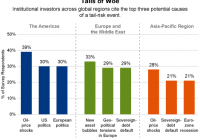
Summary Holds a near monopoly in providing the essential service of electricity to the third largest economy in Latin America. EBITDA has increased an eye-popping 93%, with 2014 electricity transmission revenues up 72.1% over 2013 revenues. Returned second 25% of principle to bondholders in Dec ’14, with half of the remaining 50% to be paid in Dec ’15 and the last 25% at maturity in 2016. This week, we revisit an issuer with a near monopoly in providing the essential service of electricity to the third largest economy in Latin America. Transener has a natural monopoly of the transmission service in Argentina. A concession agreement with the government of Argentina grants Transener the exclusive right to provide the public service of high voltage electricity transmission throughout their networks for a period of 95 years, which began in July 1993. We last reviewed these Transener Yankee bonds in August 2014 . Since that time, the company’s consolidated adjusted EBITDA has increased an eye-popping 93%, with 2014 electricity transmission revenues up 72.1% over 2013 revenues. Also worth noting is the return of another 25% of principle to bondholders, with half of the remaining 50% to be paid in December 2015 and the final 25% in December 2016. For investors, this translates to getting half of their principal back in seven months. Transener currently has $129.7 Million total debt, with a majority of this debt coming due in 2021, a full five years after these 2016 bonds have been paid. With over 11,000 miles of transmission lines, the value of the hard assets owned by Transener (lines, pole support structures, transformers, substations, right of ways, etc) easily exceeds the current amount of debt, especially when one considers the cost of constructing another network from scratch (which could easily cost $1M USD per mile according to Black and Veatch). With its increasing revenues and increasing profits, we believe there is more than adequate cash flow to continue repaying principal and interest on schedule, and the 8⅞% yield currently indicated with these Transener 2016 bonds appear to offer investors outstanding cash flow and a remarkably high short term yield relative to the risks we can identify. Therefore we are targeting them for an overweight position within our FX-1 and FX-2 income portfolios. About the Issuer Founded in 1993, Transener owns, operates and maintains 90% of the high voltage transmission system in Argentina. Transener also transports 90% of the electricity in Argentina. Prior to 1992, almost all of the Argentine electricity industry was owned and managed by the government. In the early 1990’s, a privatization program was initiated with the ultimate objective to protect consumer rights, encourage competition and investment and improve the quality of service. Currently, Transener has over 11,000 miles of transmission lines within Argentina. Pampa Energia (NYSE: PAM ), the largest integrated energy company in Argentina, has a co-controlling stake in Transener, and has traded on the NYSE in form of ADRs since October 2009. Transener’s revenue streams are largely determined by the government via the Secretariat of Energy, who approves wholesale electricity prices. Transener receives monthly revenue for transmission, capacity charges and connection charges from CAMMESA, a national organization responsible for managing operations in the wholesale electricity market. Tariffs (what they can charge for electricity) have been kept artificially low since the 2001/2002 Argentine economic crisis, when Transener’s original concession agreement was renegotiated and tariffs of electricity distributors and transmission companies were frozen. As a result, the monies collected from electric customers and consumers did not cover Transener’s cost of operations. This rolling deficit has been continually covered by federal subsidies paid to CAMMESA. After years of petitioning the government to adjust payments from CAMMESA to reflect actual production costs, Transener received some financial relief in 2013. The Renewal Agreement compensates the company for cost variations (the cost of operations not covered by tariffs and subsidies) retroactive to December 2010 and continues to December 2015. The Argentine Secretary of Energy continues to honor and make progress on the amounts determined to be due to Transener as a result of the Renewal agreement. As of December 31, 2014, Transener was still owed ARS $187 million plus an additional ARS $87 million in interest. This is the remaining amount owed of the original ARS $863 million total due to Transener as part of the Renewal Agreement. In addition, in May of 2014, the government of Argentina did grant higher electricity rates to power generators which should begin to bring much needed capital to build the infrastructure necessary to meet increasing demand. Optimism in Argentina As Argentina looks to its pending elections to be held in October this year, there is optimism that life after current president Cristina Fernandez de Kirchner will be significantly improved for the country as a whole as well as for its distressed utilities. For the utility companies and their bondholders, the hope is that the winner in October will undo the decade-long price caps imposed as a result of the 2001-2002 financial crisis in Argentina. Perhaps investor optimism is also responsible for Transener’s stock rally over the past year. Twelve months ago, the company’s stock was trading for ARS 1.81 per share. In recent trading, the share price is now at ARS 5.62, a 210% increase. The stock’s 52 week high is ARS 7.20, over three times the price from a year ago. Transener’s increasing market value also benefits bondholders by reducing risk. As a company’s value increases, its balance sheet is positively affected, reflecting less leverage/debt against the overall company value. Financials After over a decade of government controlled, artificially low tariffs, Transener has been able to realize a profit from its operations the past two years. Year 2012 2013 2014 Operating Profit 147.4 Million ARS (pesos) 3.8 Million ARS (pesos) 206.9 Million ARS (pesos) current exchange rate, 1 ARS = $0.11046 in USD. Consolidated net sales for 2014 were ARS 1.476 Billion, a 69% increase as compared to the ARS 873.8 Million of 2013. Consolidated adjusted EBITDA also increased in 2014, registering ARS 693.7 Million as compared to ARS 358.2 Million for 2013. For 2014, Transener had operating income of ARS 206.9 Million and interest expense of ARS 118.8 Million for an interest coverage ratio of 1.7x. We feel this ratio will continue to improve as payments due from the Renewal Agreement are made as well as the prospect of a full tariff review to adjust electricity rates to better reflect the consumer market. As of 12/31/2014 Transener had cash and cash equivalents equal to $36.9 Million (ARS 329.7 Million). This amount has increased significantly over the level of cash and cash equivalents from 12/31/2013, when cash totaled $8.3 Million (ARS 73.6 Million). Risks The default risk is Transener’s ability to perform. Transener’s financial picture has improved over the past two years, with the Renewal Agreement helping to bridge the gap between the cost of doing business and the amount of tariff monies collected for service. Given that the company has already paid 50% of the principal of this bond issue, and that the majority of its bond debt comes due in 2021 after these bonds have matured, we feel the default risk for these very short-term bonds is relatively low considering its high double digit returns. Geopolitical risk is also present. Argentina’s socialist government has long subsidized public utilities in the country, attempting to foster economic growth by freezing costs for basic services such as water and electricity. However, in the face of ever growing budget deficits, the government began cutting many of the long-running public utility subsidies in mid-2014, giving way to higher utility bills for consumers. The government has stopped short of finalizing a full tariff review for electricity companies, but we feel the negotiation and execution of the Renewal Agreement for Transener indicates their recognition of the vital importance of reliable electric power to ensure Argentina’s growth and economic viability. Transener’s business operates primarily in Argentina and as such, its revenues are received in Argentine pesos. This debt is issued in US Dollars so the company is exposed to risks in the fluctuations of the exchange rate between Argentine pesos and US dollars, especially as it relates to payments of interest and principal to bondholders. Given the fact that Transener has already paid off 50% of this issue’s principal, thereby decreasing their interest expense as well, this risk continues to decrease with each principal payment. These 8.875% Transener 2016 bonds appear to have similar risks, features and maturities to other Yankee bond issues such as 7.75% Hidroelectrica Piedra Del Aguila, 9.5% Autopistas Sinking Bonds, and 10%+ Transportadora de Gas Del Sur (NYSE: TGS ), previously reviewed on our Bond-Yields.com website. Summary and Conclusion Electricity is essential for everyday life, and Transener’s lines transport the electricity that is essential to Argentina’s continued economic viability. Argentina lacks the resources to either replicate or replace the services Transener provides to the country. The company’s financial metrics are improving and with this bond issue’s principal already reduced by 50%, we think the likelihood of a default is highly unlikely. With yields over 40x the current 12 month US Treasury yield, these outstanding, high-yielding, short-term bonds provide the income investor with excellent diversification with a company that commands a monopolistic, 90% market share, and it is why we are looking for to overweight this issue within our Fixed-I ncome1.com and Fixed-Income2.com global high income portfolios. Issuer: Compania de Transporte Energia (Transener) Coupon: 8.875% Maturity: has already returned ½ the principle, sinks an additional ¼ on 12/15/15, and the final ¼ on 12/15/16. Average life 6/11/2016. Callable at par after 12/15/14. Ratings: CCC- CUSIP: P3058XAJ4 Pays: Semi-annually Price: 100.0 Yield to Average Life: ~8.75% Disclosure: Durig Capital and certain clients may have positions in Transener 2016 bonds. Please note that all yield and price indications are shown from the time of our research. Our reports are never an offer to buy or sell any security. We are not a broker/dealer, and reports are intended for distribution to our clients. As a result of our institutional association, we frequently obtain better yield/price executions for our clients than is initially indicated in our reports. We welcome inquiries from other advisors that may also be interested in our work and the possibilities of achieving higher yields for retail clients .


